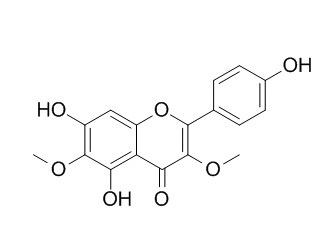3,6-Dimethoxyapigenin
Standard reference
Inquire / Order:
manager@chemfaces.com
Technical Inquiries:
service@chemfaces.com
Tel:
+86-27-84237783
Fax:
+86-27-84254680
Address:
1 Building, No. 83, CheCheng Rd., Wuhan Economic and Technological Development Zone, Wuhan, Hubei 430056, PRC
Providing storage is as stated on the product vial and the vial is kept tightly sealed, the product can be stored for up to
24 months(2-8C).
Wherever possible, you should prepare and use solutions on the same day. However, if you need to make up stock solutions in advance, we recommend that you store the solution as aliquots in tightly sealed vials at -20C. Generally, these will be useable for up to two weeks. Before use, and prior to opening the vial we recommend that you allow your product to equilibrate to room temperature for at least 1 hour.
Need more advice on solubility, usage and handling? Please email to: service@chemfaces.com
The packaging of the product may have turned upside down during transportation, resulting in the natural compounds adhering to the neck or cap of the vial. take the vial out of its packaging and gently shake to let the compounds fall to the bottom of the vial. for liquid products, centrifuge at 200-500 RPM to gather the liquid at the bottom of the vial. try to avoid loss or contamination during handling.
J Agric Food Chem.2022, 70(51):16176-16187.
J Sep Sci.2023, 46(16):e2300160.
Phytomedicine.2022, 99:154025.
Am J Chin Med.2022, 1-20.
Plant Physiol.2024, 194(4):2580-2599.
Food Res Int.2022, 157:111207.
J Biomol Struct Dyn.2022, 1-21.
Institute of Food Science & Technology2021, 56(11).
University of Limpopo2016, 1777
Sci Rep.2021, 11(1):21038.
Related and Featured Products
Herbacetin
Catalog No: CFN99778
CAS No: 527-95-7
Price: $338/20mg
8-Methoxykaempferol
Catalog No: CFN92382
CAS No: 571-74-4
Price: Inquiry(manager@chemfaces.com)
Prudomestin
Catalog No: CFN98453
CAS No: 3443-28-5
Price: $268/20mg
5,7-Dihydroxy-3,4',8-trimethoxyflavone
Catalog No: CFN99666
CAS No: 1570-09-8
Price: Inquiry(manager@chemfaces.com)
5,7-Diacetoxy-3,4',8-trimethoxyflavone
Catalog No: CFN98818
CAS No: 5128-43-8
Price: Inquiry(manager@chemfaces.com)
4',5,7-Trihydroxy 3,6,8-trimethoxyflavone
Catalog No: CFN70413
CAS No: 57393-71-2
Price: Inquiry(manager@chemfaces.com)
Calycopterin
Catalog No: CFN70374
CAS No: 481-52-7
Price: Inquiry(manager@chemfaces.com)
Araneosol
Catalog No: CFN98797
CAS No: 50461-86-4
Price: Inquiry(manager@chemfaces.com)
2',3,5,7-Tetrahydroxyflavone
Catalog No: CFN70373
CAS No: 480-15-9
Price: Inquiry(manager@chemfaces.com)
Kaempferol
Catalog No: CFN98838
CAS No: 520-18-3
Price: $30/20mg
Fitoterapia. 2016 Apr;110:52-8.
High-resolution PTP1B inhibition profiling combined with high-performance liquid chromatography-high-resolution mass spectrometry-solid-phase extraction-nuclear magnetic resonance spectroscopy: Proof-of-concept and antidiabetic constituents in crude extra[Pubmed:
26882973 ]
Type 2 diabetes (T2D) constituted 90% of the global 387 million diabetes cases in 2014. The enzyme protein-tyrosine phosphatase 1B (PTP1B) has been recognized as a therapeutic target for treatment of T2D and its adverse complications.
METHODS AND RESULTS:
With the aim of accelerating the investigation of complex natural sources, such as crude plant extracts, for potential PTP1B inhibitors, we have developed a bio-analytical platform combining high-resolution PTP1B inhibition profiling and high-performance liquid chromatography-high-resolution mass spectrometry-solid-phase extraction-nuclear magnetic resonance spectroscopy, i.e., HR-bioassay/HPLC-HRMS-SPE-NMR. Human recombinant PTP1B enzyme was used for the microplate-based PTP1B inhibition assay, which was optimized for pH and substrate concentration to be compatible with rate measurements within the 10 min incubation time. Subsequently, analytical-scale HPLC-based microfractionation followed by colorimetric microplate-based PTP1B bioassaying enabled construction of a high-resolution inhibition profile corresponding to the HPLC profile. The high-resolution PTP1B inhibition profiling was validated using an artificial mixture of known PTP1B inhibitors and non-inhibiting compounds as negative controls. Finally, a proof-of-concept study with a real sample was performed using crude ethyl acetate extract of the phytochemically hitherto unexplored plant Eremophila lucida.
CONCLUSIONS:
This led to the identification of the first viscidane type diterpene, i.e., 5-hydroxyviscida-3,14-dien-20-oic acid (9) as PTP1B inhibitor with an IC50 value of 42.0 ± 5.9 μM. In addition, a series of flavonoids, i.e., luteolin (1), dinatin (3a), tricin (3b), 3,6-Dimethoxyapigenin (4), jaceidin (5), and cirsimaritin (6) as well as a cembrene diterpene, (3Z, 7E, 11Z)-15-hydroxycembra-3,7,11-trien-19-oic acid (8), were also identified for the first time from E. lucida.
Phytochemistry.1985;24(9):2133.
Methylated flavonols from Wyethia bolanderi and Balsamorhiza macrophylla.[Reference:
WebLink]
METHODS AND RESULTS:
A leaf wash of Wyethia bolanderi afforded eight known methylated flavonols: santin, ermanin, jaceidin, 3,6-Dimethoxyapigenin, kaempferide, isokaempferide, axillarin and quercetin 3-methyl ether. A leaf wash of Balsamorhiza macrophylla afforded six known methylated flavonols: centaureidin, quercetin 3,4′-dimethyl ether, axillarin, spinacetin, tamarexetin and quercetin 3-methyl ether. The chemotaxonomy of the two genera is discussed briefly.



